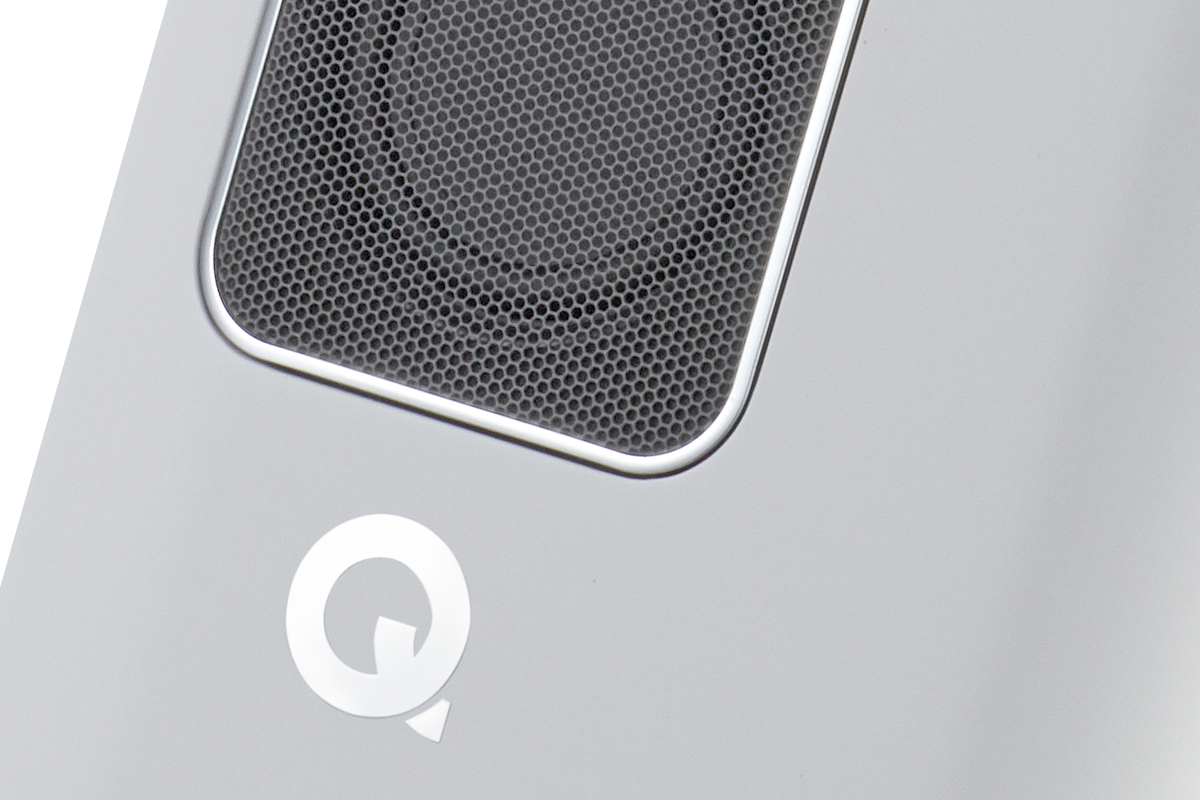At first glance, Q Acoustics’ Q Active 200 ($1999/pair, all prices in USD except where noted) doesn’t look much like a loudspeaker. It could be an appliance of some kind, or maybe a minitower desktop PC. After setting up the speakers on the matching Q FS75 stands ($499/pair) in my living room, I sent close-up pix to a few friends and family members, and asked them what kind of product the pictures showed. Those were some of their guesses.
It’s easy to understand their confusion, because there’s little to suggest that the Q Active 200 is a loudspeaker. There are no connectors—no speaker terminals, no line-level inputs. Instead, the speaker receives its signals wirelessly from the companion Q Active Hub.
On the upper area of the front baffle, offset to one side, is a 6″H × 3″W black wire-mesh grille surrounded by a silver trim ring, and below it a prominent “Q” logo. The grille is not removable, and unless you look closely, it’s hard to see there are loudspeaker drivers behind it.
While the Q Active 200 has a conventional box-shaped enclosure, Q Acoustics was clearly thinking outside the box when they designed this speaker. The Q Active 200 has a very unusual driver complement and crossover design.
The speakers
Available in matte black or matte white finishes, the Q Active 200 has rounded edges on the front, top, bottom, and sides, which gives it a funky, modern look. Each speaker measures 11.2″H × 6.7″W × 11.4″D, and weighs 16.5 pounds.
As the name conveys, the Q Active 200 is a fully active design, with dedicated amplifiers for each of its three drivers. Implemented by a digital signal processor (DSP) inside each speaker, the crossover comes before the amplifiers in the signal path. The DSP also performs other functions that are critical to the speaker’s operation, such as time alignment and equalization.
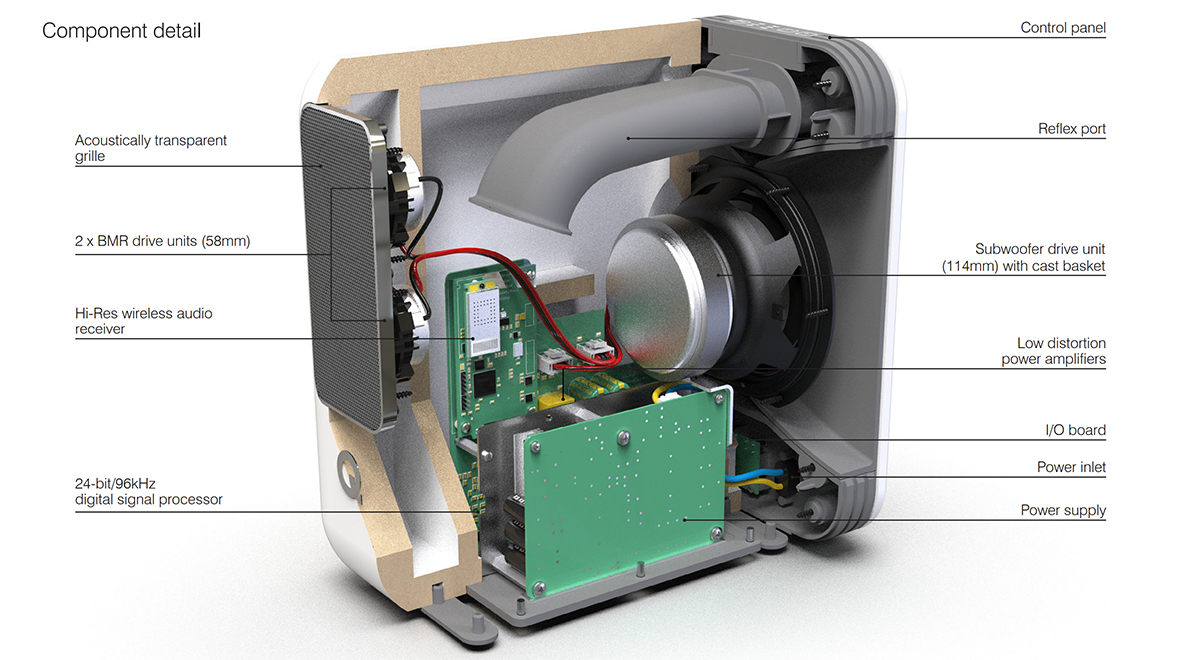
Behind the grille on the front baffle are two 2.25″ balanced mode radiator (BMR) drivers, each powered by a Texas Instruments class-D amplifier chip rated at 20W continuous. The BMR drivers are crossed over at 150Hz to a rear-firing, 4.5″ driver that Q Acoustics boastfully describes as a subwoofer. I find that a stretch, as the specified frequency response of the Q Active 200 is 46Hz–20kHz, -6dB. I’ll simply call the low-frequency driver a “woofer.” The woofer is powered by a Texas Instruments class-D amp rated at 55W continuous. Total peak output of the three amplifiers is 280W.
BMR drivers resemble conventional dynamic drivers in that they produce sound with a diaphragm that moves in response to current passing through a voice coil suspended in the gap of a permanent magnet. The diaphragm of a conventional driver (cone or dome) is intended to move pistonically—the diaphragm is rigid and moves as a unit. As a result, the breakup mode is above its passband, or in the case of a tweeter, above the threshold of audibility. By contrast, the diaphragm of a BMR driver has multiple breakup modes. At progressively higher frequencies, only the inner areas of the diaphragm move. This provides some big benefits, but poses real design challenges.
The main benefit is the ability to operate over a very wide frequency range without beaming. The Q Active 200’s BMR drivers are a case in point. The top BMR driver covers the audioband from 150Hz upward. The bottom driver is band-pass filtered, covering the range 150Hz–5kHz. According to Q Acoustics’ white paper on its Q Active series, the outputs of the two BMRs “sum in a more sympathetic manner than conventional pistonic drive units.” With this arrangement, there is no crossover in the critical midrange region—which translates to more seamless midrange performance, the company says. Yet dispersion is very wide, horizontally and vertically.
However, BMR drivers have nasty response peaks at their breakup frequencies. In a passive design, these peaks are attenuated with notch filters in the crossover, presenting the amplifier with a more challenging load. This isn’t an issue with an active design. With the Q Active 200, the DSP applies equalization to smooth out peaks at the breakup frequencies before amplification.
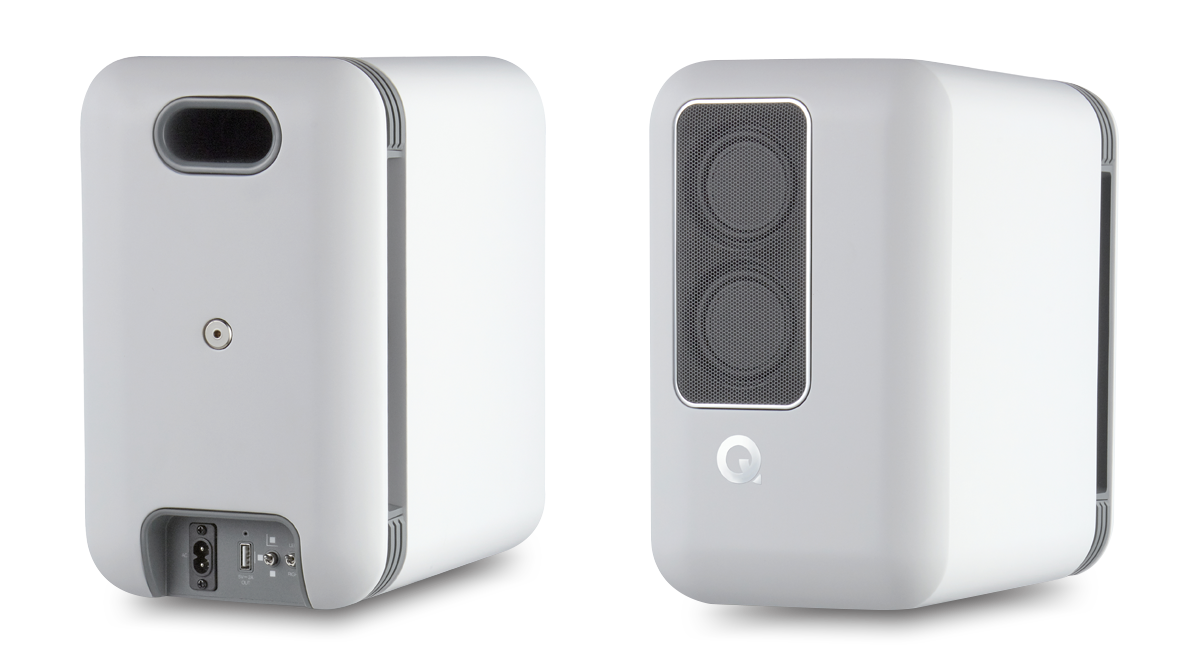
Instead of radiating sound directly to the back, the rear-facing woofer routes airflow to a boundary-control lens on the back of the speaker enclosure, in front of the woofer itself. The lens directs airflow to vents on either side of the enclosure. The DSP applies a short time delay on the signal to the BMR drivers, so that their output is time-aligned with the woofer’s.
The DSP also performs dynamic limiting to prevent damage to the drivers, and implements room boundary compensation. That feature is enabled via a three-position switch on the back of each speaker. There are three settings: for placing the speaker near a corner, near a wall, or in the open. On the lower right is a two-prong, figure-8 power inlet, and to its left, a two-position switch to select whether the speaker plays left- or right-channel content.
The BMR drivers are in the upper-left corner on one speaker, and the upper-right corner on the other. This asymmetric positioning reduces diffraction effects from the baffle, Q Acoustics says, because the path lengths from the BMR drivers to the cabinet edges are different in every direction. And combined with the left/right switch on the back, the asymmetric layout lets listeners place the speakers with the BMRs either on their inner or outer edges, thus adjusting the breadth of the soundstage.
The Q Active 200 is a rear-ported design. Port plugs are supplied for situations where the speaker is placed very close to the wall behind it. I did not use them in my listening.
On the top of each speaker, near the back, are membrane keys for cycling through sources, raising and lowering volume, and turning the speakers on and off.
Hub and remote
The Q Active 200 speakers ship with the Q Active Hub, an unobtrusive black component measuring 7.1″W × 1.6″W × 4.4″D. The Hub accepts audio from connected sources, Bluetooth devices, and networked components and transmits 24-bit/96kHz audio to each speaker using Microchip Technology’s KleerNet wireless technology.
The Q Active Hub has HDMI eARC, TosLink, and analog RCA inputs on the back. The analog inputs are switchable between line-level and phono operation via a small toggle switch. Other input options include Bluetooth 4.1, Ethernet, and Wi-Fi. There’s also a subwoofer output, which is low-pass filtered at 300Hz; a grounding post for a turntable; and a USB-C port for receiving 5V DC from the supplied wall wart.
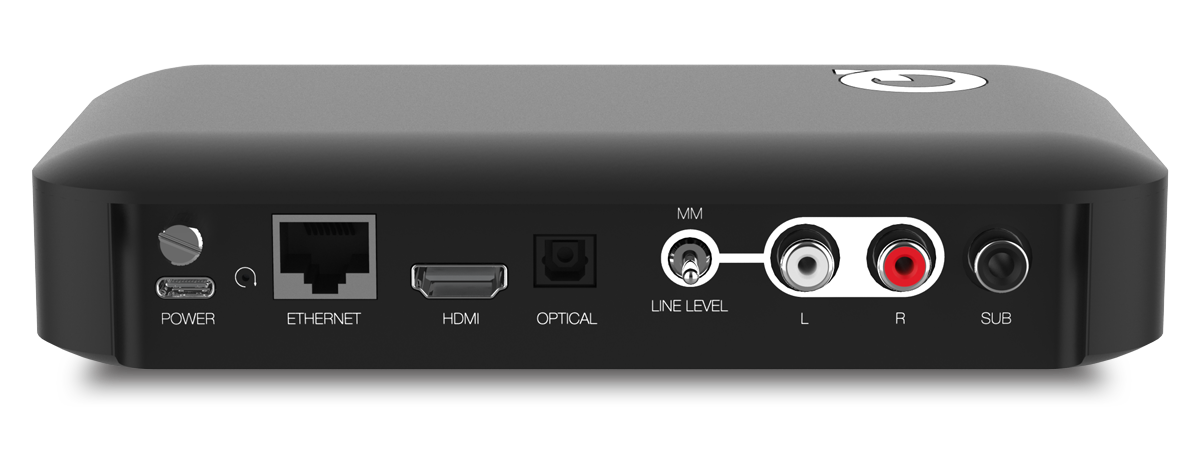
Maximum input resolution is 32/192 PCM via Ethernet and Wi-Fi, 24/96 via TosLink, and 16/96 via HDMI eARC. Regardless of input, all digital signals are resampled to 24/96; analog signals are converted to 24/96 PCM.
Q Active 200 purchasers can choose between two different versions of the Hub. The version included with my review set had Chromecast Built-in with support for Google Assistant voice control and Google Home compatibility. The forthcoming alternative version eschews Chromecast and Google Assistant in favor of Amazon Alexa support. Both versions are Roon Ready, and also support Apple AirPlay 2, Spotify Connect, and UPnP.
On the front panel of the Q Active Hub are six membrane switches and status LEDs for power on/off, remote pairing, speaker pairing, Wi-Fi reset, Bluetooth pairing, and cycling through inputs. The Hub can be placed on a shelf, or wall-mounted using keyhole slots on the back/bottom surface.
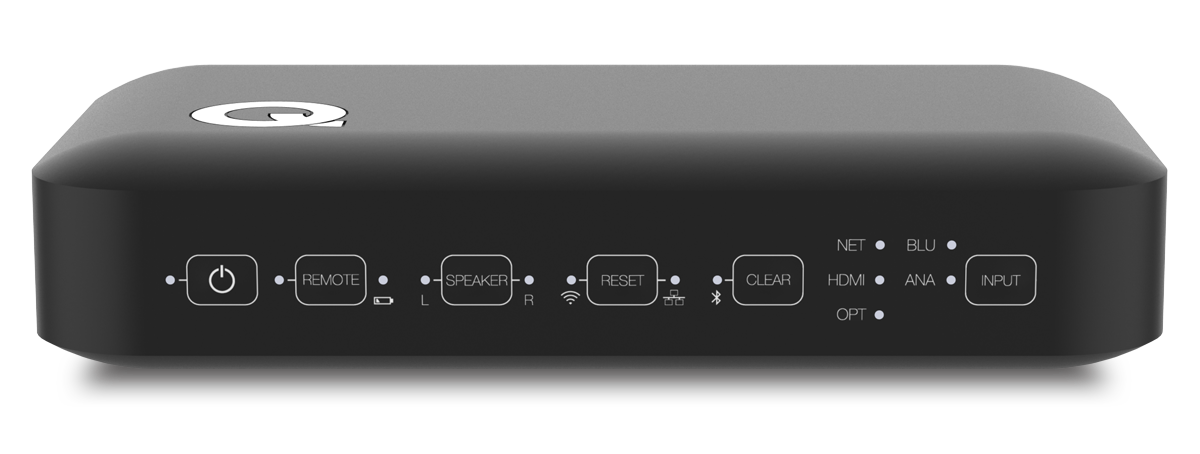
Also included with the Q Active Hub is a remote control with power on/off, mute, play/pause, track-skip, and source selection keys. The remote uses RF communications, so the Hub can be hidden away on an equipment rack or behind the TV.
Setup and software
Q Acoustics provides a useful Quick Start Guide with the Q Active 200, but it’s definitely worth downloading the full manual from the company’s website.
For my review, Q Acoustics supplied a pair of Q Active 200s in the matte black finish, plus a pair of Q FS75 stands. Instead of columns of steel or MDF, the Q FS75 stands support the speakers on four metal rods, tied together with metal cable. Assembling the stands was a piece of cake. I tightened the screws that connect the legs to the boss at the top, screwed the top plate into the boss, and then inverted the speakers and screwed the top plate of the stands into inserts at the bottom of the speakers.
I placed the speakers on either side of the electric fireplace in our living room. The speakers were 7′ apart, 7′ from my listening position on the end cushion of our sectional sofa on the opposite wall. Their rear panels were 16″ from the wall behind them. As the speakers were less than 0.5m (20″) from the rear wall, but more than 0.5m from a side wall, I set the boundary switch to the near-wall position, as recommended in the manual. And as I was listening in close to nearfield conditions, I did most of my listening with the BMR drivers oriented outward.
I connected my Pro-Ject Debut Carbon Evo turntable ($749 CDN with preinstalled Ortofon 2M Red cartridge, $499 with Sumiko Oyster Rainier cartridge) to the Q Active Hub’s analog input, and the HDMI ARC port of the One Connect set-top box for my Samsung UN55LS003 Frame TV to the HDMI eARC input on the Q Active Hub. The Samsung TV immediately set the Q Active system as the audio output, so that I could control the speakers’ volume with the TV remote when playing audio from the TV, or any source connected to it. I’ve reviewed several products with HDMI eARC that don’t work with the Frame TV, so I appreciated that the Q Active 200 did with no muss, no fuss.
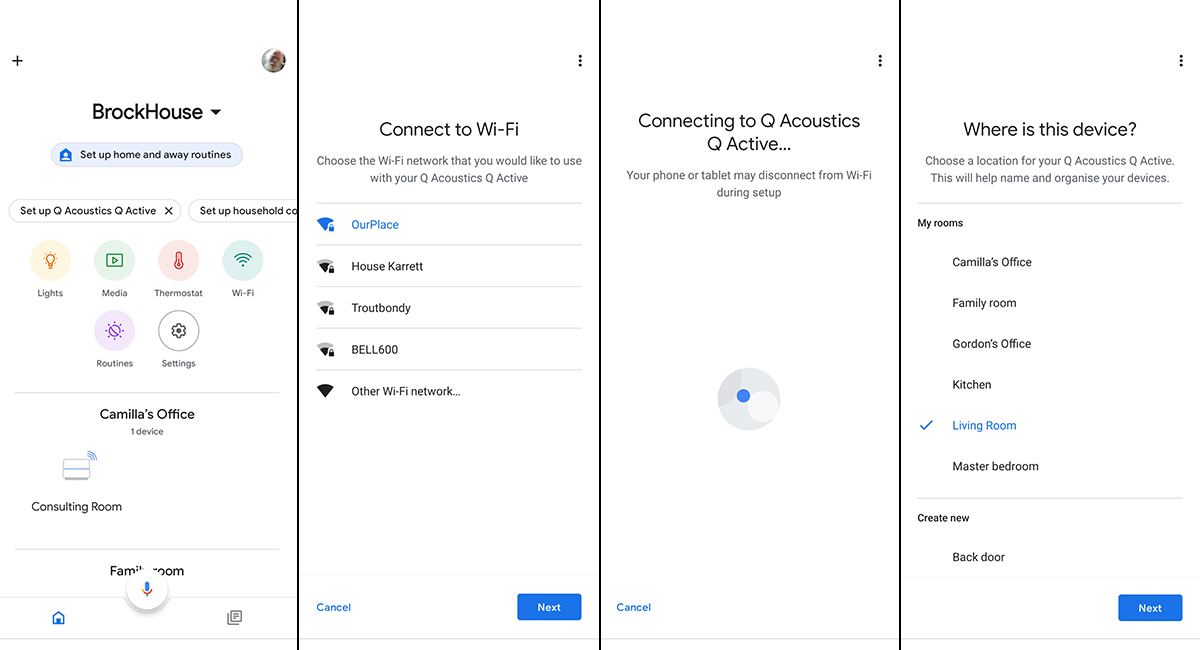
Following the Quick Start Guide, I launched the Google Home app on my Google Pixel 4a (5G) smartphone. At the top of the main menu, there was a box titled Set up Q Acoustics Q Active. After I selected this option, the Google Home app found the speakers, asked me to confirm the room where they were installed (I chose Living Room) and the name of my Wi-Fi network, and then asked if I wanted to use the saved password for that network. So far, so good. But after the Google Home app confirmed that the Q Active Hub was connecting to my network, I got an error message saying it could not connect. There was a Retry option, but when I selected it, the Set Up Q Acoustics Q Active option was no longer available.
However, the Q Active system appeared on my Apple MacBook Pro and iPhone 8 smartphone as an AirPlay device, and in Roon as a Roon Ready device. And after I restarted my Google Pixel phone, the Q Active system now appeared in the Google Home app, but not as a device in my living room. Go figure!
After that, everything went swimmingly. I was able to stream to the Q Active speakers via AirPlay 2, Chromecast, Roon, and UPnP. Throughout my testing, I never experienced any dropouts or network hiccups.
After using Google Home to set up the Chromecast version of the Q Active system, you can download the Q Active app, which is available for iOS and Android. This app can download and apply firmware updates to the speakers and Hub, and allows users to customize Hub settings, such as alert sounds and initial volumes for different sources. The Q Active app will also be used to set up the Alexa version of the Hub, when it becomes available.
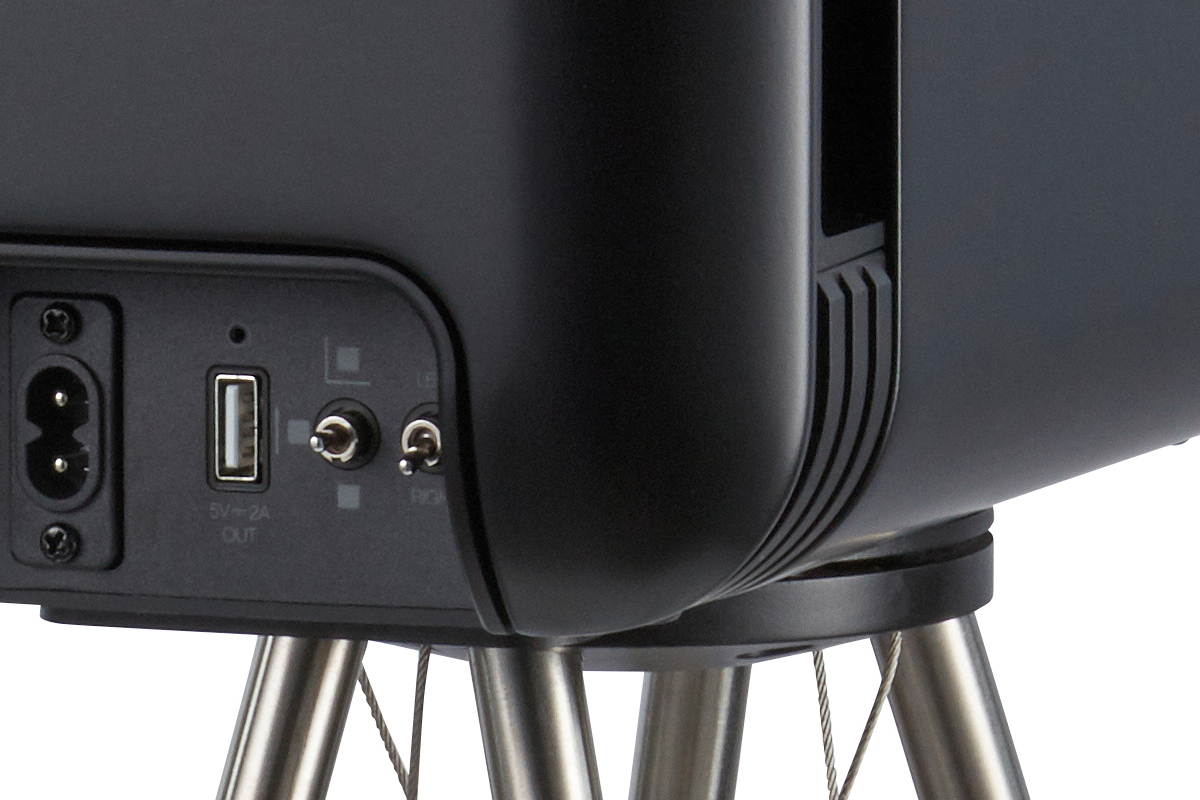
The Q Active app doesn’t have any functionality to connect to music streaming services. You can stream from an iOS device or Mac via AirPlay, from Cast-enabled apps via Chromecast, and from apps that support the UPnP/DLNA protocol.
One drawback of Chromecast and UPnP is the lack of support for gapless playback. Streaming the famous medley at the end of the 2019 Super Deluxe Edition of the Beatles’ Abbey Road (24-bit/96kHz FLAC, Universal Music/Qobuz) from the Qobuz app on my Pixel smartphone, Chromecast inserted a short gap between each track. The same thing happened when I streamed the medley from the Audirvana app on my MacBook Pro via UPnP. In both cases, the gap lasted less than a second; but it was still disruptive to have total silence instead of one song segueing into the next. There was no such issue streaming via Roon, or from my iPhone 8 via AirPlay, because both Roon and AirPlay support gapless playback. But AirPlay does not support hi-rez audio—it converts everything to 16/44.1 ALAC.
Listening
I did almost all of my listening from Roon, but also spun some vinyl on my Pro-Ject ’table. Something I noticed when playing records is that the Q Active Hub’s phono stage is a tad noisy. With nothing playing, I could hear mild hiss from my listening position 7′ from the speakers with the volume set at a comfortable level. There was no noise with any of the other inputs. However, when actually spinning records, electronic noise was masked by the program content—and any surface noise on the record itself.
Several characteristics emerged throughout my listening.
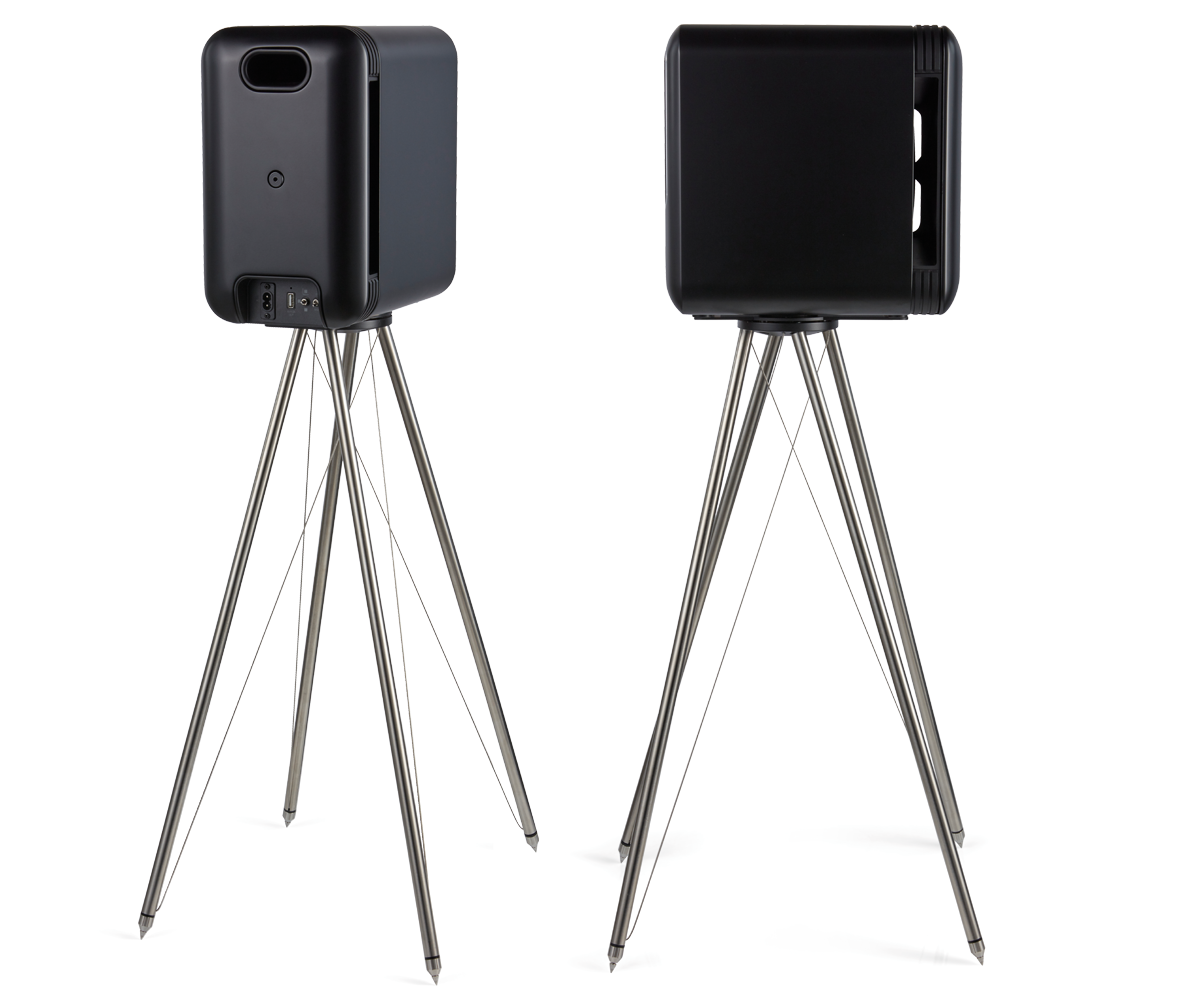
Bass was big and robust for such small speakers, but the deepest notes sounded a bit boomy and indistinct. Was the boominess caused by the speakers, or bass modes in my listening room? A bit of both, I think. And sometimes I found myself wishing for a bit more air and sparkle on the top end.
But just about everything between these extremes was magic. Midrange clarity was outstanding, creating a sense of immediacy that made it seem like the musicians were in the room with me. In particular, I loved how these little speakers reproduced male and female voices. With the BMR drivers covering the entire vocal range, voices had a coherent quality that made them sound more embodied, more human than I’m used to hearing through speakers that split the vocal range between different drivers. They were almost completely free of coloration; the only exception being some soprano notes, where sometimes a touch of stridency crept in. I also noticed this with piano.
Placed so that the BMR drivers were on the outer edges of the speakers, the Q Actives threw a soundstage that extended well behind and beyond the speaker plane. With the drivers on the inner edges, the soundstage was a little narrower, but the location of aural images a little more precise.
Timbral balances remained consistent as I moved off axis, horizontally and vertically. I also loved the way instruments and voices emerged on that soundstage—a drummer’s tap on a wooden block or cowbell here, a background singer’s doo-wop there—and the way these touches blended in with the principal performers.
Not surprisingly, these compact speakers had their limitations. At high volumes, the sound became a little hard and congested, and some dynamic compression crept in.
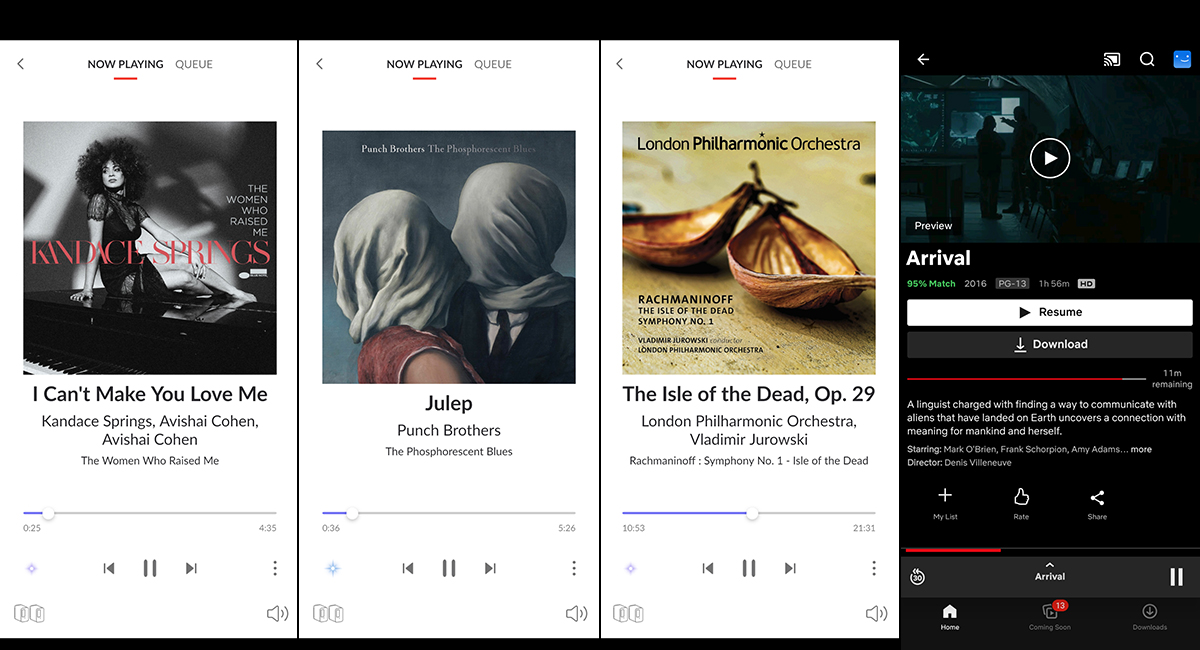
Many of these qualities were evident when I played Kandace Springs’s warm, mournful rendition of “I Can’t Make You Love Me,” from The Women Who Raised Me (LP, Blue Note Records B003159701JK02) on my Pro-Ject ’table.
Through the Q Actives, her rich alto voice sounded completely natural through its entire range. Consonants and sibilants were clear and crisp, but not at all spitty. The Q Actives beautifully presented the slightly breathy quality at the top of Springs’s range, without accentuating it.
Springs’s piano had lovely clarity in the middle and upper octaves, and satisfying authority in the lower octaves. Avishai Cohen’s trumpet had a wonderful golden, burnished tone. His expressive blowing, again perfectly articulated without being etched, made his instrument sound almost like it was about to sing lyrics. However, Clarence Penn’s floor tom, struck with mallets, sounded a tad thuddy; so did the lower notes of Scott Colley’s double bass.
As wonderful as the vinyl version of “I Can’t Make You Love Me” sounded through the Q Actives, a hi-rez digital version of the same song (24/96 FLAC, Blue Note Records/Qobuz), streamed from Roon, was even better. The digital version didn’t have the warm glow of the LP, but everything was better defined. Consonants and sibilants were a little clearer, but still perfectly balanced with Springs’s vowels. This made me a bit more aware of her expressive word-painting. However, I also heard a smidge of hardness on her top notes.
The soundstage was a little higher and deeper, and the aural images more specific, with the digital stream. Springs’s piano had more sparkle up top, more heft down low. Transients were faster, so I could better appreciate her touch and pedaling. I was also more aware of Cohen’s blowing effects during his solo, which made his trumpet sound even more expressive. Again, the balance of breath and golden, burnished tone seemed ideal. Penn’s mallet strikes on the floor tom were more clearly defined, but the thuddiness remained.
The Q Actives performed just as well with male voices, as I confirmed by playing “Julep,” from Punch Brothers’ The Phosphorescent Blues (16/44.1 FLAC, Nonesuch Records/Qobuz). On this beautiful song about love, loss, and the passage of time, Chris Thile’s slightly nasal tenor voice sounded completely natural—it was as if he were in the room, right between the speakers, and slightly behind and above the speaker plane. As with the Kandace Springs recording, Thile’s sibilants and consonants were ideally clear, not the least hot or spitty, and completely integrated with his vowels, so that his voice sounded fully embodied and human.
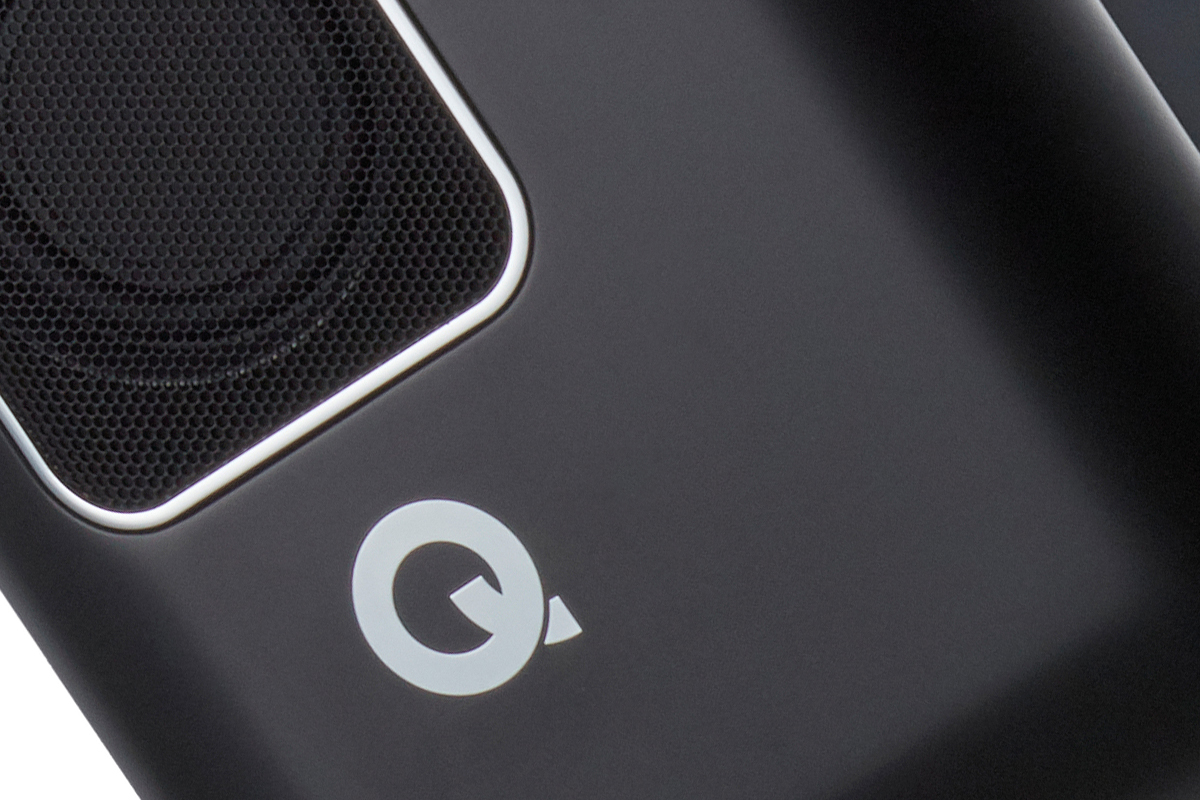
The band’s bluegrass instruments also sounded wonderful. In the left center of the soundstage, Paul Kowert’s pizzicato attacks on double bass had perfect snap, and decayed beautifully into a rich, woody glow—except for the very lowest notes, which were a little indistinct. On the right side, Noam Pikelny’s banjo plucks were fast without being etched, and segued naturally into a rich twang. Gabe Witcher’s fiddle, in the left center of the soundstage, was rich and rosiny, and never steely or strident. Much as I enjoyed the way the Q Actives presented individual voices and instruments, what really impressed me was the way they integrated these elements into a complete musical performance. Through the Q Actives, it was evident that the whole was more than the sum of the parts.
A live recording of Sergei Rachmaninoff’s tone poem The Isle of the Dead, performed by the London Philharmonic Orchestra and conducted by Vladimir Jurowski (24/96 FLAC, LPO/Qobuz), highlighted the Q Actives’ strengths and limitations. The low harp notes and strings in the ominous opening were luscious and full, but also transparent. Front-to-back layering was very good, and imaging commendably precise. The way little flourishes appeared as if from nowhere—a high, plucked harp phrase here, a solo flute phrase there—was almost magical.
Instrumental timbres were generally spot-on. The violins sounded sweet, and never steely; cellos were rich and woody, and had a nearly human quality. However, the lowest notes of the double basses and the timpani, beating out a funereal rhythm, sounded a bit thuddy.
Dynamics scaled up and down very naturally, until the intense, dramatic passages in the middle of the work, where I found the limits of these compact active speakers. In orchestral crescendi, the sound became a little hard and congested. There was also some dynamic compression.
I listened to this piece with the BMRs on the outside, and again with them on the inside. As I’d expected, the soundstage was a little wider with the drivers on the outside, but aural images were a little more precise with them on the inside. It was basically a coin toss.
To hear how the Q Actives would reproduce the soundtrack of a big sci-fi movie, I streamed Arrival from Netflix to my Frame TV, whose One Connect set-top box was connected to the Q Active Hub’s HDMI eARC port. The deep, rumbly sound effects aboard the alien vessel didn’t shake the room—how could they, through such small speakers? Nonetheless, they were impressively powerful. So were other effects, like helicopter and jet flybys. While the sound in these big moments was a little compressed, it was never strident or harsh.
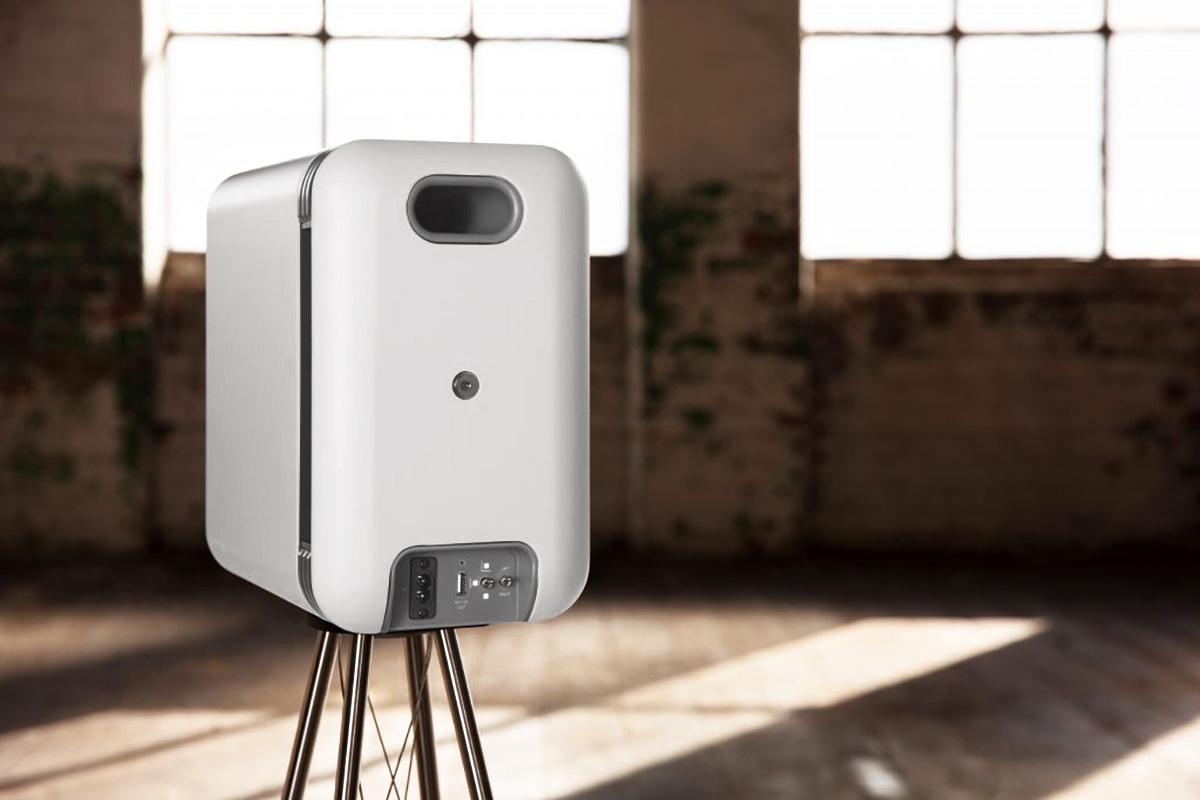
It wasn’t just the big moments that impressed. Dialog was consistently intelligible and free of coloration. And the sound of Max Richter’s “On the Nature of Daylight,” which accompanies the scenes about the daughter of the lead character (Dr. Louise Banks, played by Amy Adams), was exquisite. The two violins had a lovely silvery tone, and the viola and cellos had a wonderful woody glow—again, quite human-sounding, as on the Rachmaninoff recording. However, the deep notes of the Moog synthesizer, played by Richter, had an indistinct, droning quality.
Comparison
I compared the Q Active 200s with KEF’s LS50 Wireless II active speakers ($2499.99/pair), which I placed on 28″H Monoprice Monolith stands. Before listening, I matched levels on both sets of speakers to within 0.5dB using pink noise and a sound-pressure level meter. For the comparisons, I streamed music from Roon.
Midrange clarity was better on the Q Actives—they were more seamless through the midband. But the KEFs had greater low-frequency definition and better transparency in the highs.
On “I Can’t Make You Love Me,” Kandace Springs’s voice sounded a tad darker on the Qs. Sibilants and consonants were slightly more prominent through the KEFs, and so were the breathy accents at the end of some of her phrases. The portrayal of her rich alto was wonderful on both sets of speakers, but just a little more coherent through the Qs—sibilants and consonants were more of a piece. I found the Q Actives’ portrayal of her voice a bit more convincing.
The upper range of Spring’s piano had more sparkle through the KEFs, but sometime sounded a bit clangier. The lower register of the piano was richer through the Qs. While I heard a little more of Avishai Cohen’s expressive blowing through the KEFs, these effects were better integrated with the golden tone of his instrument on the Qs. Through the KEFs, Scott Colley’s double bass and Clarence Penn’s floor tom sounded richer and deeper, and significantly more defined. There was still some thuddiness, but I’m sure that was down to my room.
The presentation through the KEFs was a tad more open, and a tad more congested through the Qs. Aural images were more precise with the KEFs.
In the opening of The Isle of the Dead, the rolling bass drum and timpani were more articulate on the KEFs. The bowed bass violins had more texture, more growl through the KEFs. But there was something about the Qs’ coherent midrange that enabled them to convey the power of the orchestra—and the rolling motion of the boat in the painting that inspired Rachmaninoff’s composition—more convincingly. The presentation was just a bit more disjointed through the KEFs.
In the loud, dramatic sections in the middle, the sound through the KEFs became a little congested and compressed, but much less so than it did with the Qs. As a result, instrumental groupings were more clearly differentiated through the KEFs. The KEFs also delivered sudden orchestral flourishes more effortlessly than the Q Actives. Through the KEF LS50 WIIs, the soundstage was wider, deeper, and taller; and the instrumental groups were more precisely located.
Conclusion
As I noted in my introduction, the Q Active 200 is a very unusual looking speaker, especially when mounted on the Q FS75 stand. The styling won’t be to everyone’s taste, but those who like it will really like it. Functionally, these little active speakers deliver a whole lot for under $2k—they practically exemplify Simplifi’d hi-fi.
I’ve picked a few nits about the Q Active 200s. If you’re relying on Chromecast to stream hi-rez music, the lack of support for gapless playback may be an issue, and during my listening, the low bass sometimes sounded a little indistinct. Also, at high volumes, the sound could become dynamically compressed, and occasionally congested. But let’s be real: limitations in dynamics and bass performance are inevitable with speakers this small. What’s more impressive is how effectively Q Acoustics uses DSP and the active design to mitigate these limitations.
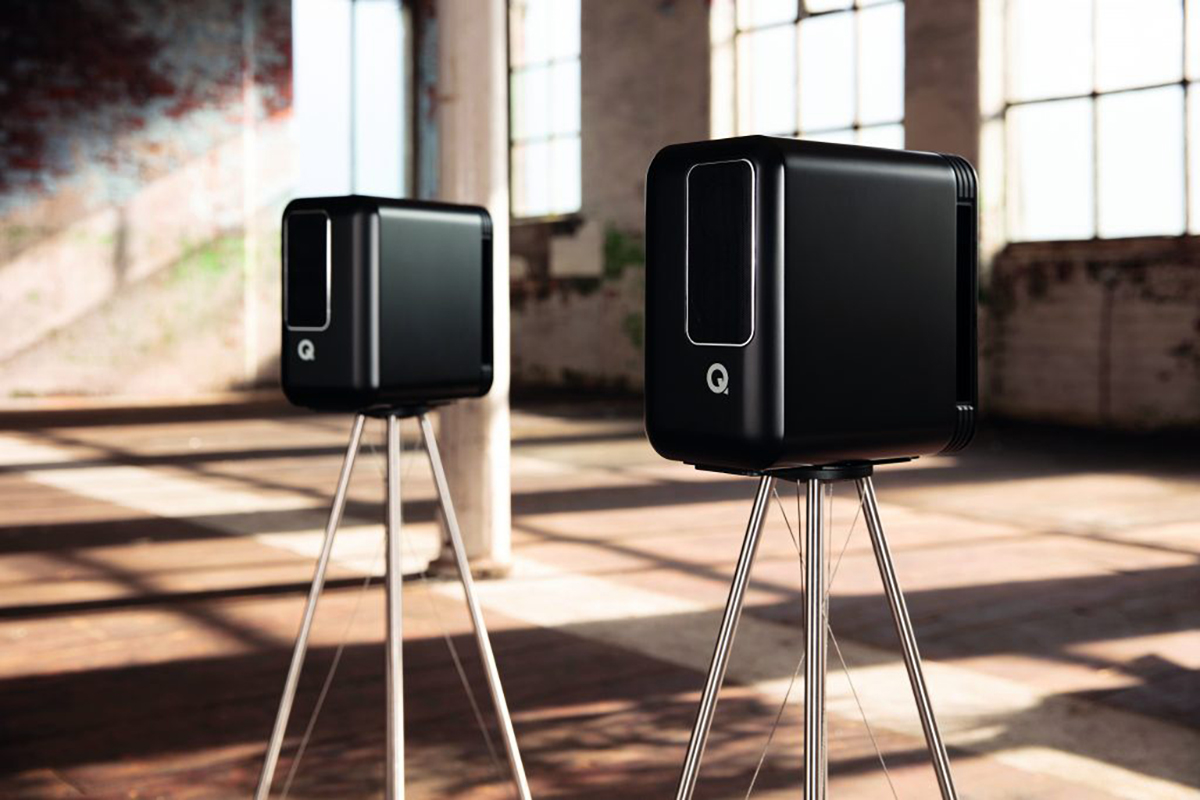
In any event, these limitations aren’t what I’ll remember most about the Q Actives. What will stay with me is their wonderful immediacy, and their clear, coherent midrange. I’ll remember the way this made singers sound more human, and tied disparate elements into a complete performance.
Now, when I listen to speakers that divide the midband between two or more drivers, I’m sometimes aware of a very subtle discontinuity, which I never noticed before hearing the little Qs. I’ve encountered only a few products that change the way I listen. Q Acoustics’ Q Active 200 is one of them.
. . . Gordon Brockhouse
Associated Equipment
- Active loudspeakers: KEF LS50 Wireless II.
- Speaker stands: Q Acoustics Q FS75, Monoprice Monolith (28″).
- Turntable: Pro-Ject Debut Carbon Evo with Ortofon 2M Red cartridge.
- Digital sources: Apple Mac Mini running Roon Core 1.8, Apple MacBook Pro running Audirvana 3.5.46.
- Display: Samsung UN550S003 55″ HDTV “The Frame.”
- Control devices: Google Pixel 4a (5G) and Apple iPhone 8 smartphones.
- Network: Google Wifi four-node mesh network.
Q Acoustics Q Active 200 Active Loudspeakers
Price: $1999 USD per pair; add $499 per pair for matching Q FS75 stands.
Warranty: One year parts and labor; two years parts and labor with registration.
Q Acoustics
Armour Home Electronics
Woodside 2, Dunmow Road
Bishop’s Stortford
Hertfordshire CM23 5RG
United Kingdom
Website: www.qacoustics.com
